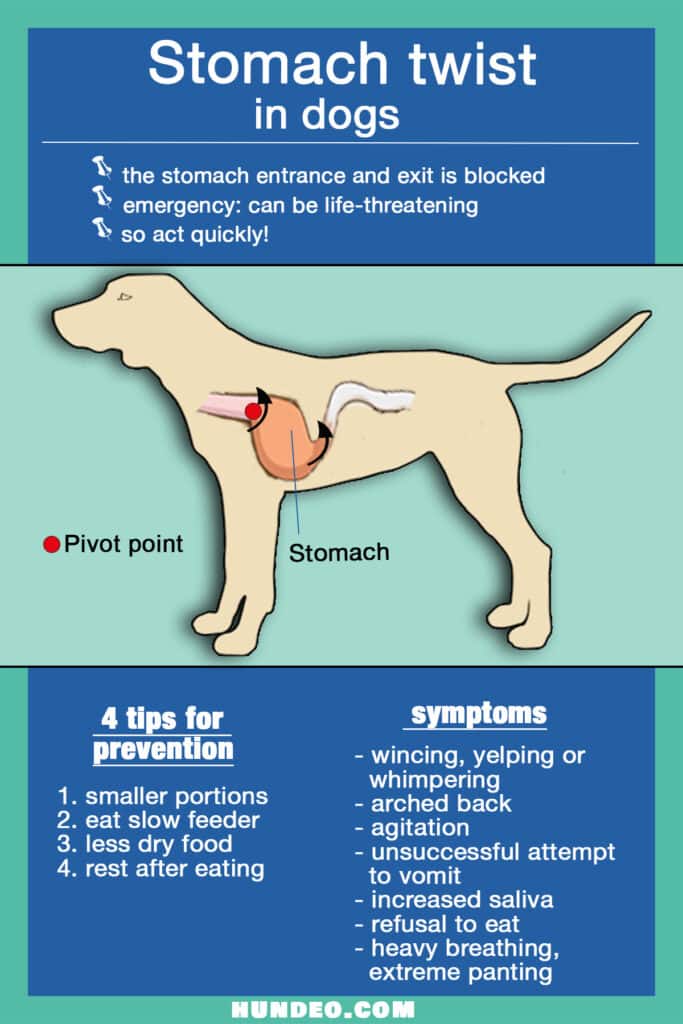Stomach torsion in dogs (recognize signs and help)
- Veterinarian Mag.med.vet. Emin Jasarevic
- Updated: 2023-04-11
Want to know more about gastric torsion in dogs? Recognize their signs and know how to properly prevent them? Then you are in the right place! Also, for this article, we got advice from veterinarian Mag.med.vet. Emin Jasarevic. So be curious.

Even though gastric torsion is rare, it can have serious consequences and can be fatal if not treated quickly.
What is gastric torsion?
The stomach of a dog hangs on two flexible ligaments. In addition, the stomach is somewhat stabilized at its entrance by the esophagus. The same happens at the stomach outlet through the small intestine.
Nevertheless, the stomach is very mobile and elastic. This is important if your dog eats a large portion.
However, this mobility also has a disadvantage. The stomach swings back and forth. If your dog makes an unfavorable movement, it can the stomach rotate around its own axis.
Because the stomach cannot turn back on its own, fatal complications occur. The rotation closes the stomach inlet and outlet and the gases can no longer escape. The stomach continues to inflate and thus damages other organs.
If gastric torsion is not treated by a veterinarian within a few hours, this emergency is life-threatening. But if you act quickly, you increase the chances of survival of your pet.
Therefore, as an owner, you should definitely recognize the signs of gastric torsion. Then you have to react quickly and correctly.
6 factors of gastric torsion
Gastric torsion can occur in any furry cat, regardless of risk factors. The actual cause of this life-threatening condition is not yet known.
However, an has observed that gastric torsion occurs more frequently under certain conditions.
1. food and drink
Gastric torsion rarely occurs on an empty stomach. When your dog has eaten or drunk something, the natural swinging of the stomach increases. The probability of a complete rotation is therefore higher.
Especially large portions of food are a risk factor. Hard to digest food stays longer in the stomach and increases the risk even more. If your dog in addition eats or drinks quickly, the risk of gastric torsion is even greater.
2. unfavorable movements
If your pet runs up and down the stairs at high speed or rolls on the floor, the stomach will resonate. If he has eaten something just before, it can lead to gastric torsion.
However, it is increasingly observed that it can occur in the evening and at night when the dog is at rest. The reason for this is a higher susceptibility of some dog breeds to gastric torsion.
3. large, deep-set chest
Some dog breeds are more at risk than others. This is especially true for larger dogs that have a wide chest. The stomach lies lower there and has more freedom of movement. This makes it all the more likely to turn on its own axis.
Therefore, dog breeds such as boxers, German shepherds, Great Danes and Dobermans suffer from gastric distortion more often.
4. gastrointestinal inflammation
There are associations of gastrointestinal problems with an increased risk of gastric torsion. Especially with vomiting, diarrhea and poor digestion, you need to watch out for possible symptoms of torsion. You can minimize this risk point by preventing digestive problems through a balanced diet.
5. age
The older your dog gets, the more his ligaments stretch. The connective tissue and ligaments that hold the stomach in place also slacken over time. Because of this, the stomach will turn completely much faster than a tight puppy.
6. stress
As with many other conditions, stress is a risk factor for gastric torsion. Why gastric torsion occurs more frequently in stressed quadrupeds has not yet been researched. But it could be because stressed animals eat faster and make more frantic movements.
If several of these factors apply to your dog, the risk of gastric distress is greater. You should then pay much closer attention to signs of this disease. But even small dogs or puppies can be affected.
The risk factors only increase the probability. Gastric torsion can occur even without them.
Gastric torsion has serious consequences
Once the stomach has turned on its own axis, its two outlets are closed. The previously ingested food causes gases to form that are normally released into the esophagus or small intestine. However, since they can now no longer escape via these exits, the stomach continues to inflate.
After some time, the stomach is much too large for the abdominal cavity. The surrounding organs and especially the blood vessels are strangulated.
First, the Diaphragm impaired. This is because it lies directly next to the stomach. Due to the constriction, it can no longer expand sufficiently and breathing becomes more difficult.
The surrounding Heart Vessels are cut off. Now blood exchange can no longer take place: The old, oxygen-poor blood is no longer transported away and the organs are no longer supplied with new, oxygen-rich blood.
If the tissue does not receive new oxygen, it is permanently damaged and may even die. The stomach, as well as all surrounding organs, can be affected.
If the tissue of the stomach wall becomes leaky as a result, food residues and gastric acid can get outside into the abdominal cavity. This can be a serious Peritonitis have as a result.
Through these consequences the Heart heavily loaded and impaired cardiac activity. Not infrequently therefore occur Cardiac arrhythmias on. After a few minutes the Circulation heavily loaded. If the gastric torsion is not treated after a few hours, the result is a Circulatory shock.
Since the stomach cannot turn back on its own, gastric torsion without help is always fatal.
Detect gastric torsion

The rotation itself causes a short sharp pain. You can do this on a short Wince, Yelp or Whimper of your protégé. Unfortunately, very few people think of gastric distortion when they see this symptom.
After all, it also occurs only rarely. Nevertheless, you should now observe your pelt-nose even more closely. The sooner you recognize the disease, the greater the chances of survival of your pet.
Dogs retract their belly, after her stomach has turned. Also a curved back is a sign.
Probably your four-legged friend after a gastric torsion very restless. He notices that something is wrong. By he constantly changes its position, he wants to get better. So he keeps alternating between lying down, standing up and walking.
If your furry friend tries to vomit, he will not succeed. Because the connection between stomach and esophagus is closed. If he should drink something, it will come up again after only a few seconds. That is why he will refuse food.
The saliva can now no longer flow off sufficiently and therefore collects in the mouth. That's why dogs sometimes foam at the mouth after gastric torsion.
After only a few minutes inflates the stomach right behind the ribs strongly up. You can either see this from the outside or feel it. If you gently flick against its belly, it sounds hollow.
With time...
With the passage of time also deteriorates the Circuit. The initial restlessness then becomes Indifference and Apathy. The breathing becomes heavier and your protégé pants more. If you have the Pulse measures, it is probably fast.
After only one hour, the symptoms can be so pronounced that your darling can no longer stand up. If more time passes, it quickly becomes a life-threatening situation.
Therefore, you should immediately consult a veterinarian after the first symptoms. If your dog can only lie down, it will be difficult to transport him.
Here you will find a summary of the most important symptoms:
- Flinch, yelp or whine
- retracted abdomen
- curved back
- Unrest
- Constant change of position
- futile attempt to vomit
- increased saliva
- Food refusal
- distended stomach
- Stomach sounds hollow
- Circulation problems
- Indifference
- heavy breathing, heavy panting
- Fast pulse
- white mucous membranes
In case of suspicion: Act quickly
As soon as you suspect that your pet is suffering from gastric distress, you should immediately drive to a veterinarian or animal hospital. It is best to call ahead. This way you can be sure that the practice is open. In addition, your doctor can better prepare for the procedure.
Tell the veterinarian as precisely as possible which symptoms apply to your four-legged friend. With the help of an X-ray, he can check whether it really is gastric torsion.
Treatment
In this case, the most important thing is to drain the gas from the stomach. This makes the stomach smaller and the blood can flow to all organs again. For this purpose, either a tube is brought into the stomach through the mouth or a cannula is placed directly into the stomach.
If the stomach is not completely twisted, the veterinarian can also turn it back by applying some pressure. In most cases, however, this is not so easy. Then it must be brought back into the correct position by surgery.
The vet needs a lot of calm and concentration for this procedure. Therefore, do not distract him with questions or nervousness.
However, you can ask him before the operation to make a Gastropexy to be performed. This means that the stomach is partially sutured to the abdominal wall. This way, the risk of the stomach turning again is much lower. This is useful if your pelt nose is particularly prone to stomach twisting.
Even after a successful surgery, some complications may occur. The likelihood of a dog surviving or not despite surgery is clearly determined by how quickly you, as the dog's owner, acted in the event of gastric torsion. Veterinary observation after surgery is highly recommended.
4 Tips for prevention

Gastric torsion can occur even without risk factors. The causes have not yet been fully researched and therefore prevention is also very difficult.
Still, you can avoid some factors that increase the likelihood of gastric torsion:
1. smaller portions
If your little one eats a lot at once, the stomach is filled. As a result, it swings more and already it can come to a gastric torsion. This is especially dangerous if you only give him a large portion once a day. Several small portions are healthier and reduce the risk of gastric torsion.
2. anti-wrestling bowl
Also, if your pet eats too fast, this increases the risk. A Anti-wrestling bowl can remedy the situation. Through special protuberances, your furry friend can no longer eat as quickly as before.
3. less dry food
Wet food is more digestible than dry food. It does not remain in the stomach as long and does not bloat additionally. So if your four-legged friend eats more than just dry food, the risk of gastritis is not quite so great.
4. rest after eating
If your dog romps around and rolls on the floor right after eating, the stomach will vibrate even more. This can quickly lead to gastric torsion. So let your pet digest in peace before you play with him again or go for a walk.
These measures only help to reduce the risk of gastric torsion. They can in no way prevent it. That is why it is important to get information beforehand. This way you can recognize the signs quickly and take the right action right away.
Frequently Asked Questions
In gastric torsion, there is a complete rotation of the stomach around its own axis. This can happen because the stomach is relatively loosely attached in the abdomen and is free to swing. Gastric torsion is always fatal if left untreated.
A definite symptom is the abdomen, which is very distended behind the ribs. In addition, among other things: a hunched back, restlessness, increased saliva and heavy breathing.
If you suspect your dog has a stomach bug, drive to a veterinarian immediately. Call the vet beforehand so he can prepare for the necessary procedure.
Gastric torsion in dogs is an emergency. Without treatment, the stomach cannot turn back. Due to the closure of the stomach inlets and outlets, fatal complications always occur.
Rapid movements or a large portion of food can cause the stomach to vibrate strongly and turn on its axis.
Veterinarian’s Recommendation
Gastric torsion is very serious and should never be underestimated. If it is not treated within a few hours, it can become life-threatening for your protégé.
Still, be sure to stay calm. A hectic pace doesn't help anyone and only leads to rash actions. And it is important to act correctly, especially in an emergency.
As soon as you notice signs of gastric distress in your pet, you should take him to the vet immediately. Within a few minutes, your pet's health can change drastically.
Therefore, do not hesitate even if you are unsure. It is better to go to the vet once too often than to have acted too late.
It is best to deal with the issue before this emergency situation. Then you can quickly recognize the gastric torsion in an emergency and act immediately.

I am a veterinarian and writer on animal health topics. Animals are my passion, and it is my personal goal to create medically accurate articles and videos to educate pet owners as much as possible.
Share Now:
Related posts:

